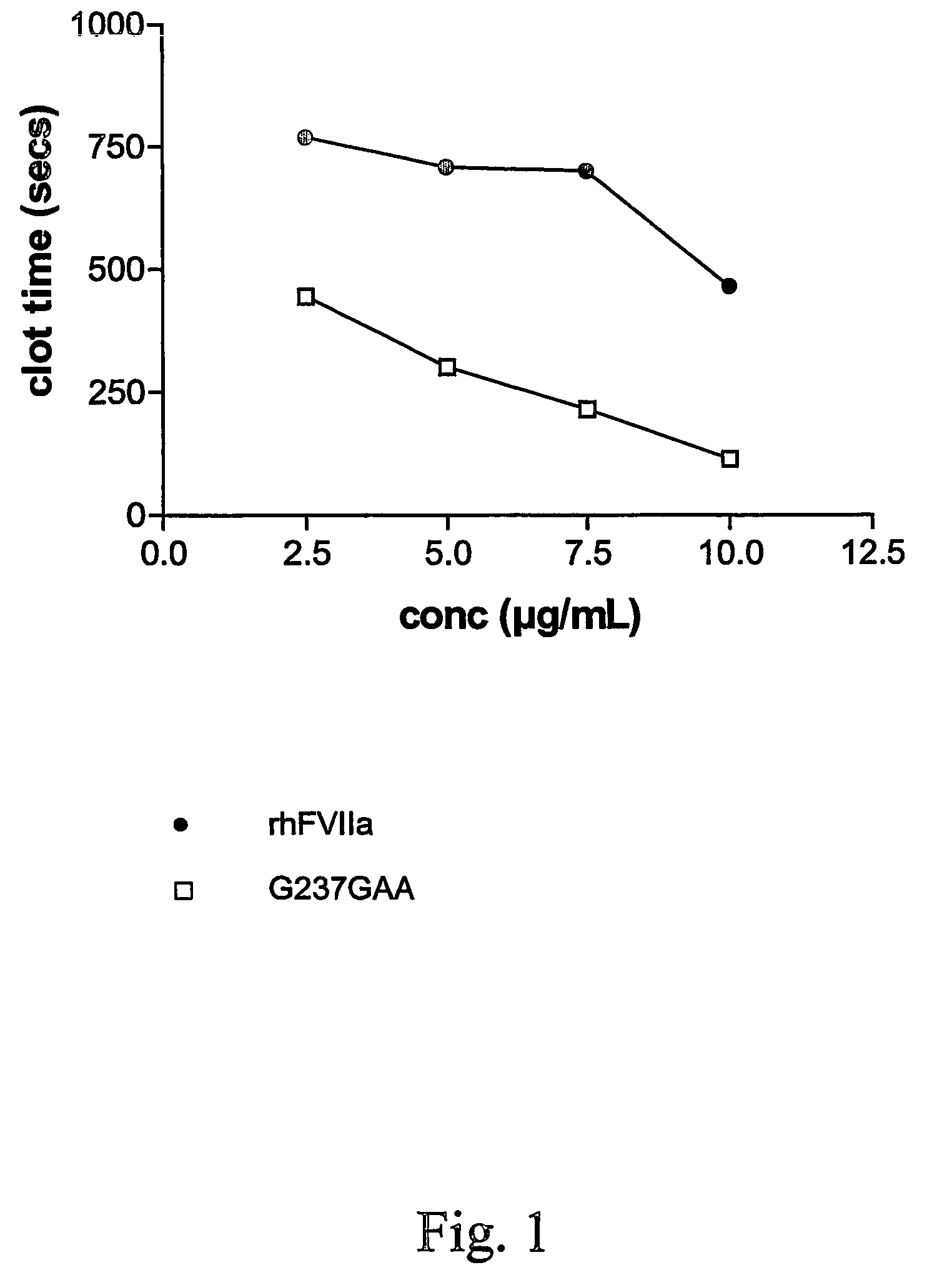FVII or FVIIa variants
a technology of fviia and variants, applied in the field of fviia or fviia variants, can solve the problems of relative instability of the molecule with respect to proteolytic degradation, difficult to obtain adequate dose regulation, and difficult to meet the patient's needs, and achieve stable soluble preparation, quick action, and easy handling for the patient
- Summary
- Abstract
- Description
- Claims
- Application Information
AI Technical Summary
Benefits of technology
Problems solved by technology
Method used
Image
Examples
example 1
[0199]The X-ray structure of hFVIIa in complex with soluble tissue factor by Banner et al., J Mol Biol, 1996; 285:2089 is used for this example. It is noted that the numbering of residues in the reference does not follow the sequence. Here, we have used the sequential numbering according to SEQ ID NO:2. The gamma-carboxy glutamic acids at positions 6, 7, 14, 16, 19, 20, 25, 26, 29 and 35 are all here named Glu (three letter abbreviation) or E (one letter abbreviation). Residues 143-152 are not present in the structure. For further information on the calculations in this example, see WO 01 / 58935.
Surface Exposure
[0200]Performing fractional ASA calculations resulted in the following residues being determined to have more than 25% of their side chain exposed to the surface: A1, N2, A3, F4, L5, E6, E7, L8, R9, P10, S12, L13, E14, E16, K18, E19, E20, Q21, S23, F24, E25, E26, R28, E29, F31, K32, D33, A34, E35, R36, K38, L39, W41, I42, S43, S45, G47, D48, Q49, A51, S52, S53, Q56, G58, S60, ...
example 2
Design of an Expression Cassette for Expression of hFVII in Mammalian Cells
[0205]The DNA sequence shown in SEQ ID NO:1, encompassing the short form of the full length cDNA encoding hFVII with its native short signal peptide (Hagen et al., 1986. Proc Natl Acad Sci USA 83:2412), was synthesized in order to facilitate high expression in mammalian cells. First the ATG start codon context was modified according to the Kozak consensus sequence (Kozak, M. J Mol Biol 1987 Aug. 20; 196(4):947-50), so that there is a perfect match to the consensus sequence upstream of the ATG start codon. Secondly the open reading frame of the native cDNA was modified by making a bias in the codon usage towards the codons frequently used in highly expressed human genes. Further, two translational stop codons were inserted at the end of the open reading frame in order to facilitate efficient translational stop. The fully synthetic and expression optimized hFVII gene was assembled from 70-mer DNA oligonucleotid...
example 3
Construction of Expression Vectors Encoding Polypeptide Variants of the Invention
[0210]Sequence overhang extension (SOE) PCR was used for generating constructs having variant FVII open reading frames with substituted codons. In the SOE-PCR both the N-terminal part and the C-terminal part of the FVII open reading frame was first amplified in individual primary PCRs.
[0211]In order to change the codon for D196 to the codon for N196 the following primers were used pairwise for the primary PCRs:
[0212]
(SEQ ID NO: 6)CB499:5′-CCCATTCTAGAAAAGCGGAACGCCAGCAAACCCCAGGG-3′and(SEQ ID NO: 7)CB562:5′-CCAATTCTTAATCTTGTTGAAGCAGTGAGCGGCG-3′,and(SEQ ID NO: 8)CB256:5′-CTCCGTGATATTGGGGGAGTC-3′and(SEQ ID NO: 9)CB561:5′-CGCCGCTCACTGCTTCAACAAGATTAAGAATTGG-3′.
[0213]The primary PCR products were then combined and the terminal primers (CB499 and CB256) were added, allowing for the secondary full-length product encoding the mutated fragment of the desired D196N variant to be made. This PCR product was restricted...
PUM
| Property | Measurement | Unit |
|---|---|---|
| molecular weight | aaaaa | aaaaa |
| molecular weight | aaaaa | aaaaa |
| molecular weight | aaaaa | aaaaa |
Abstract
Description
Claims
Application Information
 Login to View More
Login to View More - R&D
- Intellectual Property
- Life Sciences
- Materials
- Tech Scout
- Unparalleled Data Quality
- Higher Quality Content
- 60% Fewer Hallucinations
Browse by: Latest US Patents, China's latest patents, Technical Efficacy Thesaurus, Application Domain, Technology Topic, Popular Technical Reports.
© 2025 PatSnap. All rights reserved.Legal|Privacy policy|Modern Slavery Act Transparency Statement|Sitemap|About US| Contact US: help@patsnap.com

